Id Like to Continue Freely Travel
"We may have bad weather in Ireland, but the sun shines in the hearts of the people that keeps us all warm." ~ Marianne Williamson.
Peering through the small window over the aircraft's wing on approach to Dublin Airport, I couldn't believe how green the lands were beneath me. It was suddenly quite obvious to my Australian eyes why Ireland is known as the Emerald Isle, after all!
It was at this time I realised I hadn't learnt any Ireland travel tips before my visit. Admittedly this was because I hadn't even really wanted to go; I was more drawn towards Portugal for the time I had. But my partner had friends just outside Dublin he hadn't seen in a few years, so that triumphed.
And oh boy, the decision to visit Ireland was one of our best ever! We've since revisited Ireland and undertaken our fair share of road trips throughout this compact country. With a huge thanks to our Irish friends and much trial and error, I learnt so many Ireland tips that helped me to "blend in" amongst locals and have the most unforgettable experiences.
And, I'm about to share them all with you. If you're visiting Ireland for the first time, learn how to not look like a tourist from advice you won't find anywhere else by reading on for more!
This guide to Ireland travel tips will cover:
- Don't plan on only staying in Dublin
- Don't be afraid to hire a car
- Don't forget the Irish drive on the left side of the road
- Do use discretion with the speed limits
- Don't always trust your hire car's GPS
- Don't use unregulated accommodation services such as Airbnb
- Don't just turn up at the Book of Kells expecting you'll get in
- Do watch out for nettles
- Do immerse yourself in the pub culture
- Do learn what is meant by a "shout"
- Do dress up for a night out
- Don't be afraid to try Guinness or Bailey's
- Don't be easily offended
- Do go to an Irish wedding if given the chance
- Don't forget it rains a lot when planning a trip to Ireland
- Do know that English is not the native language of Ireland
- Do learn some Irish vocabulary
- Don't believe people when they say there are no castles in Ireland
- Do know the difference between Ireland and Northern Ireland
- Do remember the correct currency in Ireland
- Don't assume waiters receive your tip in restaurants
- Do visit a stone circle
This post contains affiliate links, at no extra cost to you. I may earn a small commission if you click through and make a purchase.
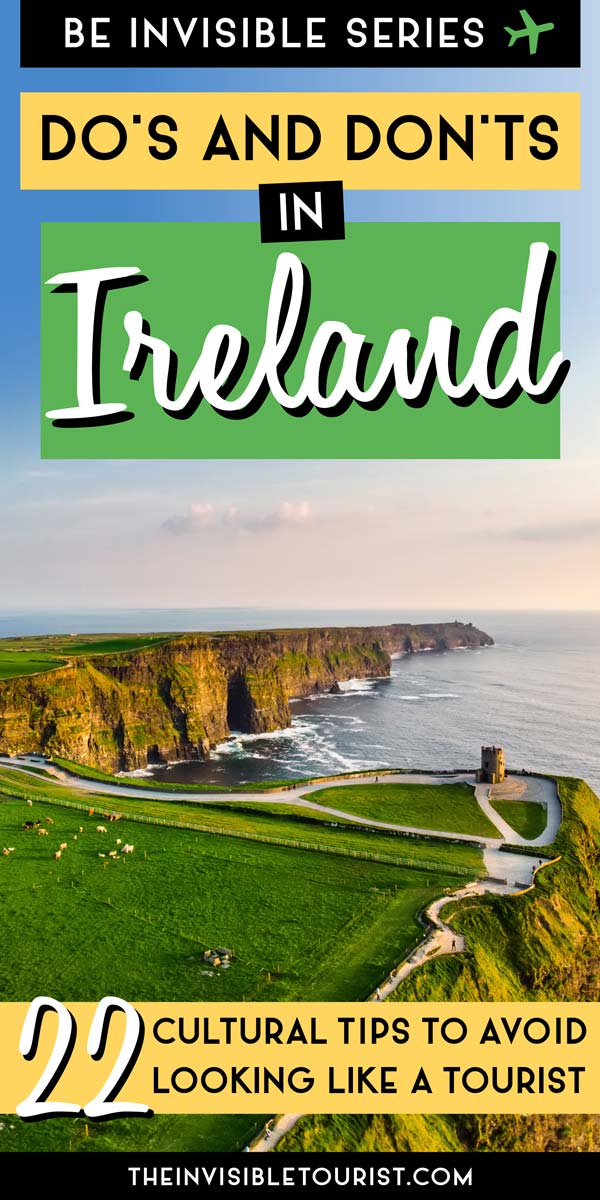
22 Essential Ireland Tips to Not Look Like a Tourist
To clarify, this article is about visiting the Republic of Ireland only (not Northern Ireland, which is a completely separate country). I need to make it very clear that tourists should absolutely know the difference to avoid any embarrassing foot-in-mouth moments during their trip – more on this down the page!
With that said, let's take a look at do's and don'ts you need to know before travelling to Ireland for the first time.
1. Don't plan on only staying in Dublin
While Dublin deserves a few days of your time to explore, you'll be doing Ireland (and yourself!) a disservice by not venturing outside of the country's capital.
The rolling green hills of the Irish countryside are so beautiful and peaceful, and some of the scenery along the winding oceanside roads is simply breathtaking. Not to mention Irish hospitality, especially in rural areas, is some of the best you'll ever experience.
Towns and areas outside of Dublin I've visited & recommend
| • Waterford | • Ring of Kerry |
| • Wexford | • Emo |
| • Cork | • Athlone |
| • Galway | • Portarlington |
| • Limerick | • Cashel |


2. Don't be afraid to hire a car
Hiring a car allows you the freedom to visit destinations in a relaxed way at your own pace, which I'd argue is the best way to see any country. Public transport such as buses around Ireland can be a bit patchy.
Did you know it only takes 2.5 hours to drive from one side of the country to the other? Ireland's compact size is perfect for exploring by car, and it's easy to book accommodation such as traditional B&Bs at your pit stops.
TIP: You can hire a car from Dublin airport here.
There are some important things to remember when driving in Ireland, however…
3. Don't forget the Irish drive on the left side of the road
Speaking of driving, please remember to drive on the left side of the road. As with Australia, New Zealand, the UK and Japan, Ireland is one of only 76 countries that don't drive on the right-hand side.
For my American and Canadian readers, this means you may jump into the passenger side by accident when you were expecting to take the driver's seat – trust me, I've done it enough in other countries to know it's very likely to happen to you, too!
In all seriousness though, over the decades tourists have been known to cause serious head-on road accidents in Ireland by forgetting they need to keep left. If you're not used to this, please be extra cautious.
TIP: As a pedestrian, this means you should look to the RIGHT first when crossing the road!
4. Do use discretion with the speed limits
Another Ireland tip for the roads! I'm not sure why but it seems sometimes there are inappropriate speed limits for the roads in Ireland.
For example, I've driven on a road where the speed limit was 100km/h when heading down a sleep cliffside with more hairpins than a bride on her wedding day.
Also, sheep tend to roam on the roads in rural areas quite a lot. Use your discretion and drive at a responsible speed for the conditions.
TIP: And remember speeds are in kilometres per hour, not miles!

5. Don't always trust your hire car's GPS
This is one of the Ireland travel tips I learnt the hard way: When driving around the country, stay on the highways. Ignore your GPS if the robotic voice tries to tell you otherwise.
Unfortunately for my partner and I on our first Ireland trip, our GPS had been set to take the shortest route – not the fastest. This meant we would be instructed to venture off the highway onto narrow tractor trails to save time as it was a shorter route… IN THEORY.
Well, it turns out farmers and their tractors make good use of these narrow trails and it's inevitable you'll be stuck driving at a snail's pace behind them. Each side of these trails are lined with hedges and other greenery, making it impossible to overtake.
6. Don't use unregulated accommodation services such as Airbnb
It's no secret that unregulated homestay accommodation has caused immense issues for locals around the globe, and Ireland is no exception.
Locals in Dublin faced crippling issues from tourists using Airbnb for short-terms stays, with skyrocketing rents and a lack of long-term rentals pushing them out of their own city.
Alternatively, help locals directly by opting to stay in regulated accommodation such as hotels, motels and traditional B&Bs – yes, where a host is present and will actually cook you breakfast!
TIP: If you're unsure what I mean by all this, my detailed guide to problems with Airbnb outlines the details.

7. Don't just turn up to the Book of Kells expecting you'll get in
Located within the incredible library of Trinity College in Dublin, the Book of Kells is a handwritten manuscript that dates back to the 9th century.
Its rich history combined with colourfully illustrated pages and old Latin text depicting Gospels of the New Testament makes it a huge drawcard for visitors.
Hoping to see it, my partner and I ignorantly turned up at 9am. The queue was crazy and not even moving, so in disappointment we cut our losses and went somewhere else instead.
8. Do watch out for nettles
Here's one of the more unusual Ireland travel tips… My Aussie partner and I had no idea about these seemingly innocent weed and their vicious sting 😆
All it takes is brushing against their hairy stems to trigger a horrible burning sensation. My partner learnt that the hard way and described it as feeling like his leg was on fire.
If you're stung by nettles, resist scratching the affected area as much as humanly possible. The more you scratch, the more aggressive and painful it becomes!
TIP: Apparently adding vinegar to the sting helps to alleviate the pain.
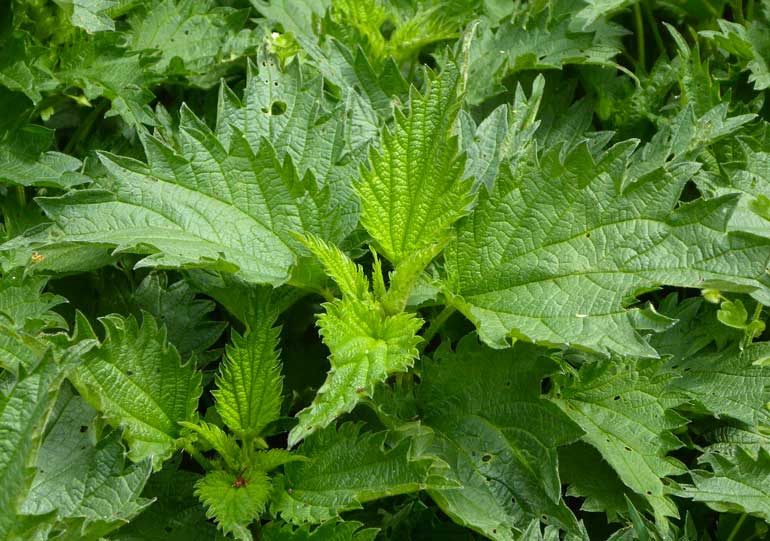
9. Do immerse yourself in the pub culture
When planning a trip to Ireland, be sure to include some local pubs. Getting into the pub culture of Ireland is a wonderful way to meet locals and make friends. Irish people are so polite, friendly and will treat you like family!
Dublin's famed Temple Bar neighbourhood was once the place to be, however in recent years it's become more touristy and overpriced according to my local friends.
Some alternatives in Dublin for a great night out include:
- Camden Street pubs & bars
- Peruke & Periwig for cocktails (book in advance)
- 37 Dawson Street Late Bar & Food Emporium
- Zozimus Bar for award-winning cocktails (do dress up!)
- Cafe En Seine (another one to dress up for)
- Baggot Street Lower is lined with old pubs and cool eateries
- Harry's on the Green on King Street
- Alfie's on William Street
- Pygmalion on Grafton Street


10. Do learn is meant by a "shout"
No, this doesn't mean the yelling kind. When out with a group of friends in a pub environment, a shout refers to whose turn it is to buy a round of drinks, for example, "It's Alyse's shout this time."
I'm not so sure of the origins of the shout, but in the UK, New Zealand and my home of Australia it could be because we need to line up at the bar to purchase drinks. They aren't usually brought over to our tables.
Participating in a shout means a group of friends can keep conversing at the table while one person goes up to the bar and purchases for the group, rather than each person having to individually line up in lengthy queues all the time.
Say I'm at the pub with 4 friends, we'd all agree to take it in turns buying a shout. Everyone gets 4 drinks by not having to keep lining up at the bar and it's win-win.
TIP: There is etiquette when joining in a shout. By joining it is expected that if someone buys a drink for you, you'll repay them by buying one in return when it's your shout. An unwritten rule is that it's rude to accept a drink if you have no intention of buying one back.
11. Do dress up for a night out
Ladies, it's time for an uncomfortable discussion. While fashion these days seems to be loungewear or activewear in Australia, New Zealand and the United States, turning up to a pub or bar in Ireland wearing this kind of attire makes visitors realllllly stand out… and not in a good way.
Irish girls put a lot of effort into their outfits, make up and hair when going for a night on the town. To blend in, I suggest you do the same to not appear underdressed!
Guys in contrast however, not so much. They seem to be able to get away with collared tartan shirts and white sneakers.
12. Don't be afraid to try Guinness or Bailey's
If you don't fancy one, it's likely you'll enjoy the other! Why not give these two national alcoholic beverages a try during your time in Ireland?
It's believed Guinness, the Irish stout beer that was created in 1759, has many health benefits – yes, really!
Studies on ingredients used in Guinness have shown:
- A pint has around 3% of adults' recommended daily iron intake
- Phytoestrogen is said to promote bone density
- Antioxidant compounds slow down cholesterol deposits on arteries, which is beneficial for the heart.
Fun fact: It takes 6 official steps and a 2 minute process to pour the perfect pint of Guinness.
On the other hand, Bailey's is made of 50% cream from local cows and Irish whiskey, giving it a sweet and smooth finish. It's best enjoyed straight or over ice, "on the rocks." It's one of my personal favourites and is SO easy to drink!
TIP: If the 17% alcohol content in Bailey's is a bit strong for you, add a dash of milk to dilute it.

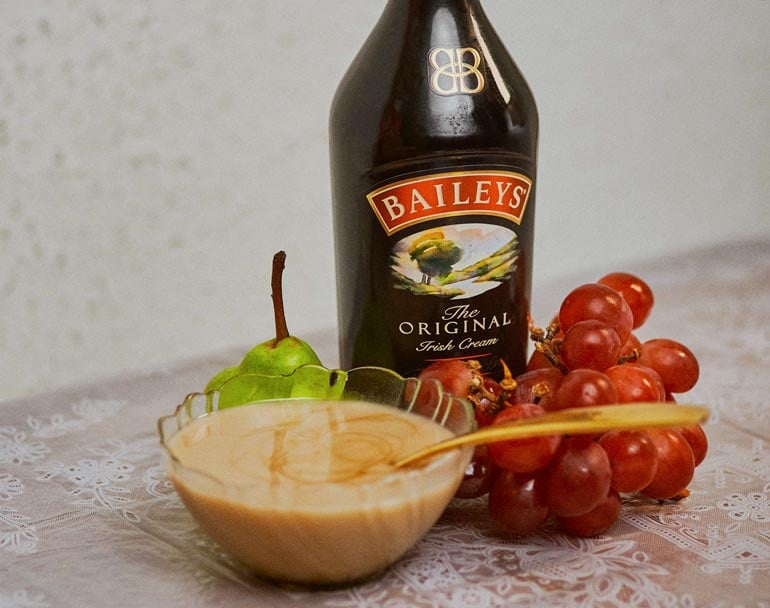
13. Don't be easily offended
Irish people LOVE to joke around, it's what makes their company so much fun. Their lighthearted humour is one of the many reasons why some of the best nights out in my life have been in Ireland.
If you only take one thing away from these travel tips for Ireland, I mean it when I say don't be offended. Any one-liners are well-intended and made in jest. Laugh along and take it as a compliment that they like you!
14. Do go to an Irish wedding if given the chance
We were invited to the wedding of our dear friends and let me tell you, if you get the chance to go to an Irish wedding you won't regret it!
For starters, unlike an 11:30pm finish time like we have here in Australia, in Ireland there is no set finish time for wedding receptions; the party kicks until there is a last man standing (for that wedding it was around 4am, haha).
Speakers get their speeches out of the way early on to allow tables to be cleared to the sides and most of the reception venue becomes a huge dancefloor. There was traditional music, professional Irish dancers, a never-ending stream of food and drinks.
But it doesn't end there! The following afternoon is just as much fun at a local pub, where wedding guests meet again for a meal, more drinks and dancing to a "trad band." As the night progresses, people take it in turns to sing traditional Irish songs acapella.

15. Don't forget it rains a lot when planning a trip to Ireland
The Northern Jet Stream cuts right across Ireland, meaning it rains A LOT. Prepare for that if it's something you're not used to at home. Moody grey skies are the norm.
The island's geographical location on the edge of the Atlantic Ocean also means It can also get crazy windy. Places along the Wild Atlantic Way such as the Cliffs of Moher and Galway especially so!
Packing a waterproof wind jacket is a good idea if you're not a fan of getting wet. Some waterproof shoes for sight-seeing are a good idea, too.
16. Do know that English is not the native language of Ireland
Did you know the native language of Ireland is Gaelic ( Gaelige in Irish)? You'll see it on every street sign.
The Republic of Ireland as we know it today only became so in 1949. Since the 12th century, its lands were occupied by England, therefore English became the second official language.
If English is your first language, it's likely you'll find the pronunciation of Gaelic words quite difficult.
With its alphabet consisting of only 18 letters, the way Gaelic words are spelt sounds completely different to how we would expect those same letters to sound in English.
According to a 2016 census, around 39% of the population in Ireland can speak Irish, that's 1.7 million people. It's more widely spoken on the western coasts of the island.
I personally find names of places and people especially interesting:
- The girls' names Siobahn sounds like "shivon," and Aoife sounds like "eefa"
- The town Portlaoise is pronounced like "Port-leash"
- The word for vegetables glasraí sounds like "gloss-ree"
- The word for glass gloine sounds like "gli-nya"
- Read more here if you're interested in learning some Irish words.
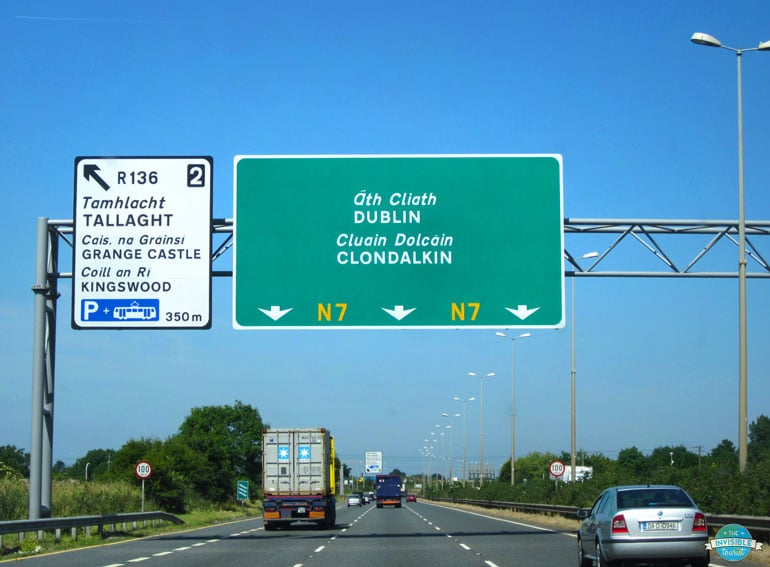
17. Do learn some Irish vocabulary
This is one of the most crucial travel tips for Ireland. Although Irish people speak English, they have so many unusual sayings you likely haven't heard before!
It's a good idea to familiarise yourself with some of the more common Irish phrases. Below are a few I heard all the time and picked up on:
- Ye – You
- Ye man – "Your man" in reference to a man you were just talking about
- Ye one – "Your lady" in reference to a woman you were just talking about
- Work away – Carry on with what you were doing
- Only after – Something you just did
- Craic – What's happening; a great time
- The yoke – The thing you can't remember the name of
- Grand – It's great; all good
- Giving out – Being told off by someone.
TIP: Find out what essential resources I use to learn languages for travel, and fast.
18. Don't believe people when they say there are no castles in Ireland
Now I'm not sure if my B&B host was pulling my leg during my first trip to Ireland, but she mentioned there were no castles to be found. Naively I believed her initially, until we began our road trip itinerary and saw castles (and ruins of them) all the time!
Some noteworthy castles in Ireland you should visit
- Blarney Castle, County Cork – For 600 years, kissing the sacred Blarney Stone set into the castle walls was believed to give you "the gift of the gab" (tourists may be hesitant to do this due to hygiene these days, but that's the legend!)
- Bunratty Castle, County Clare – A great cultural experience at this preserved 15th century castle. Learn how lords and ladies once lived and enjoy a medieval banquet night.
- Cahir Castle, County Tipperary – Impressive 13th century castle used as French Court in the TV Series Reign.
- Dublin Castle, County Dublin – Built in the 13th century on an old Viking settlement and was the seat of the ruling English and British governments when they claimed sovereignty over Ireland for 7 centuries.
- Dunguaire Castle, County Galway – Lovely 16th century castle overlooking Galway Bay.
- Johnstone Castle, County Wexford – Framed by a stunning lake and proud peacocks strolling its grounds, the castle is Gothic Revival in style.
- Rock of Cashel, County Tipperary – Perched high on a hill overlooking the town and dates back to the prehistoric Irish Iron Age (1000 BC). Consists of an old chapel, graveyard and brick watchtower. It's one of Ireland's UNESCO World Heritage sites.
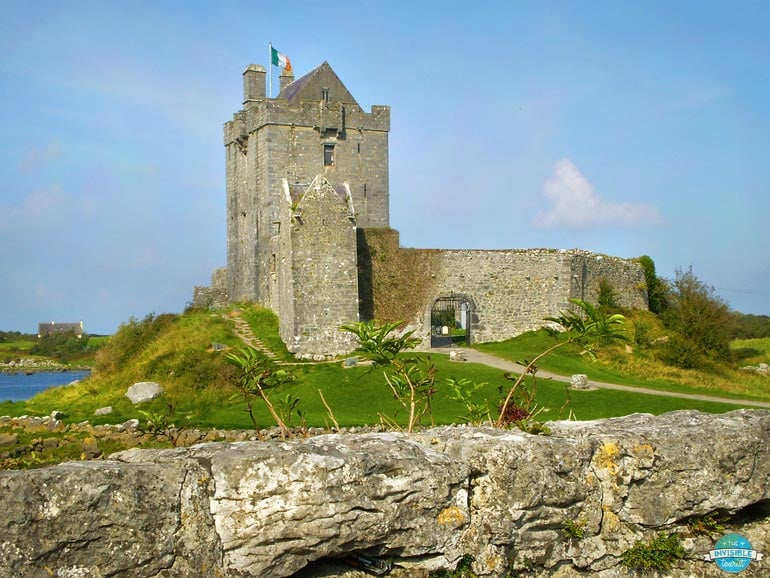
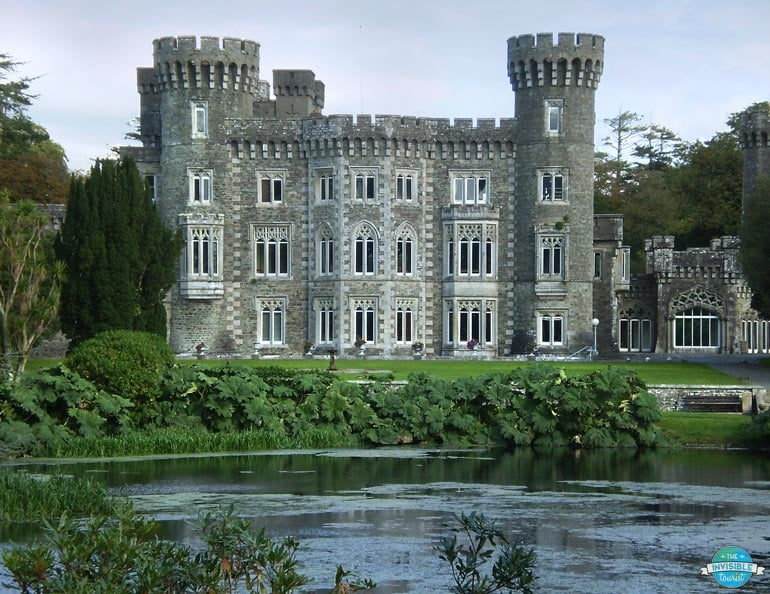
19. Do know the difference between Ireland and Northern Ireland
If you weren't familiar, the island of Ireland is made up of two separate countries: The Republic of Ireland (or simply Ireland), and Northern Ireland.
A quick crash course to simplify what can be confusing
- The United Kingdom (UK) is made up of England, Scotland, Wales & Northern Ireland.
- Great Britain (GB) is just England, Scotland & Wales.
- The European Union (EU) is made up of 27 member states on the European continent.
The differences between Ireland & Northern Ireland
- Ireland (known locally as Eire )
- Not part of The United Kingdom or Great Britain
- Is part of the European Union
- As mentioned earlier, Ireland gained independence in 1949.
- Northern Ireland
- Is part of the United Kingdom
- Not part of Great Britain or the European Union.
TIP: Read more about the separation of the two Irelands and why here.
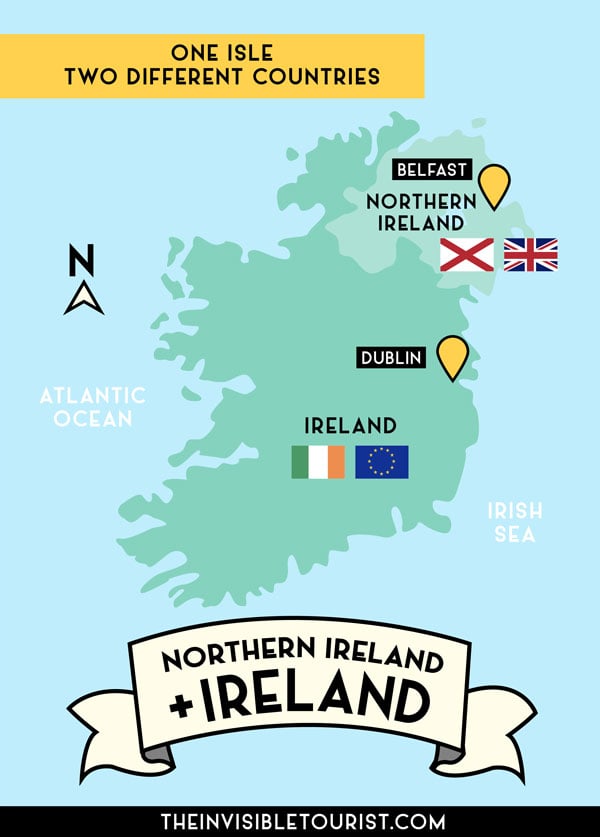
20. Do remember the correct currency in Ireland
While the United Kingdom including Northern Ireland uses the Pound Sterling, Ireland uses the Euro.
If you're crossing the border between Ireland and Northern Ireland, remember to switch your currencies over, too.
21. Don't assume waiters receive your tip in restaurants
In restaurants in Ireland, it's common practice to leave 10-15% of the bill as a tip for the waiter. Some establishments will already add this to the final bill. If this is the case, there's no need to leave a tip. Make sure to check first.
However, not all tips are created equal.
It's been revealed that when customers pay by credit card, some tips aren't passed on to the waitstaff and instead kept by upper management who are on a salary. If you would like your tip to end up in the hands of your waiter, leave them some cash when paying the bill.
When it comes to taxis, tipping is not expected but appreciated. You can round up to the nearest 5 euros if you feel so inclined.
22. Do visit a stone circle
Scotland isn't the only place to find these mysterious gifts from the past!
We stumbled across Drombeg Stone Circle in County Cork during our first Ireland road trip. This ring of large stones wedged into the ground was so fascinating, dating back to the Bronze Age (2000 – 1500 BC).
In the centre of the circle, visitors leave offerings in the form of coins, candles, stones, shells, fern leaves and more. Nearby are stone ruins of what were huts used by their inhabitants to cook food over fire.
These ancient people also used to boil their food by rolling heated rocks from the fire into a nearby makeshift trough of water. According to modern experiments, 300 litres of water in this trough could be brought to the boil in 18 minutes, and stay warm for 3 hours!
Overlooking grassy fields to the horizon, my partner and I were so fortunate we had this special place to ourselves. It's so significant to Irish culture it's now protected under the National Monuments Act. It's quite humbling to see how connected people once were to their lands.
More stone circles in Ireland include:
- Uragh, County Kerry
- Glebe, County Mayo
- Beltany, County Donegal
- Grange, County Limerick
- Knocknakilla, County Cork
- Ardgroom, County Cork
- Keakill, County Cork

Concluding these Ireland travel tips to help you "blend in"
From language to knowing the differences between countries, to social culture and stunning natural scenery, I hope you think this is the best travel advice for Ireland and you use these tips to blend in for an unforgettable trip!
I hope this overview of do's and don'ts in Ireland has helped you feel more confident for your visit. Always remember, practising good manners and etiquette in Ireland is key.
If you want to learn my strategies for how to "blend in" anywhere around the globe to enrich your trip, find out by reading my #1 Amazon New Release Book!
Is there anything you wish you knew before visiting Ireland? Do you have any other points you would like to add to this list? Let me know!
If you enjoyed this Ireland travel guide or are planning to use it on your trip, I'd love if you could share it around. Feel free to come and join me on Facebook,Pinterest,Instagram or TikTok for more travel inspiration!
Until next time,

Like it? Pin it! 📌

Booking.com
This guide to Ireland tips contains some affiliate links, at no extra cost to you. I may earn a small commission if you decide to make a purchase and if you do, thanks for your support! This helps with the costs of running my blog so I can keep my content free for you. As always, I only recommend a product or service that I genuinely love and use myself!
Source: https://www.theinvisibletourist.com/ireland-travel-tips/
0 Response to "Id Like to Continue Freely Travel"
Post a Comment